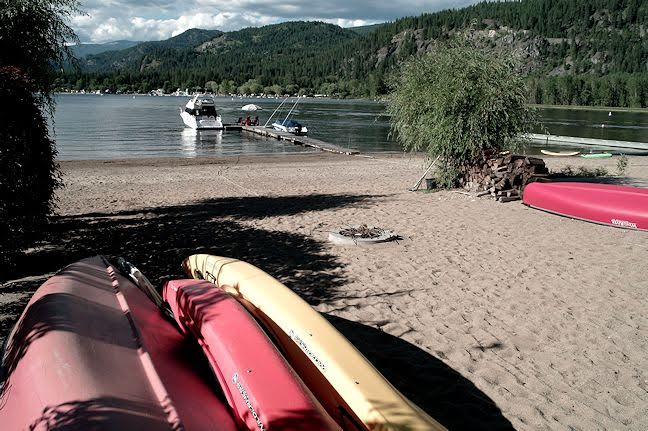by John Thomson
Big Rock Candy Mountain isn’t just a song; it’s a working mine in Boundary Country, that strip of British Columbia just above the U.S.- Canada border in between the Okanagan and the western Kootenay Mountains. Kind of in the middle you might say. Rich in minerals and farmland, the U.S. claimed it as their own until the Oregon Treaty of 1846 established the 49th parallel as the international border. Today, it’s the nearby Albertans who flood this tranquil bit of paradise, drawn to Christina Lake, the warmest tree-lined lake in British Columbia, unusual for this province where most lakes are glacier-fed. Move over Albertans, there’s enough to see and do in Boundary Country for everybody.

Christina Lake is long and narrow, running 18 kilometres from the town of Christina Lake north to Gladstone Provincial Park with plenty of campgrounds and RV parks along the way. Paddleboards can be rented from the town’s outfitter WildWays Adventure Sports. “It’s nice and warm if you fall in,” says the owner, while boats and kayaks are available from Christina Lake Marina 12 kilometres north of town. Many go to the north-east end of the Lake to see Sinixt First Nations pictographs believed to have been painted between 200 and 300 years ago. It’s a lengthy paddle but the effort is well worth it; the drawings can only be seen from the water.

Boundary Country is traversed by the Trans Canada Trail, most of which is reclaimed right-of-way. A hundred years ago, the Kettle Valley Railroad carried copper ore to the nearby smelters. No more. The rails were torn up and today, hikers and cyclists enjoy meandering through tunnels and over trestles. Other nature walks in the area include Riverwalk Trail, a gentle, meandering pathway that follows the banks of the Kettle River. It starts in the village of Midway. The Lower Granby Trail in Grand Forks follows the Granby River and a pull-out off Highway 3 just outside the town of Christina Lake (just follow the signs) takes you to a promontory overlooking Cascade Falls, a thunderous torrent of water surging though the Cascade Gorge. There are over 70 trails in Boundary Country.
Boundary’s a nature lover’s playground for sure but the area is also steeped in pioneer history. The weather-beaten sign outside Greenwood’s Deadwood Bakery says it all, “If You Like the Old West This is the Place for You.” Gold was discovered in 1859 and copper about the same time. Greenwood’s main drag is lined with old-timey storefronts and if it looks just like a movie set, well, it was. The town was featured in the Hollywood movie Snow Falling on Cedars. Cast and crew no doubt enjoyed a few beers at the colourful Greenwood Saloon, still functioning today as the area’s primo watering hole.

Eventually, the mines failed after the seams ran dry and the price of commodities plummeted. It’s an eerie feeling walking among the concrete foundations in Phoenix, a once prosperous mining town 13 kilometres east of Greenwood but its legacy lives on through Boundary’s many tours and museums. The Greenwood Museum is chock- a-block with artifacts and tools of the trade. The Kettle River Museum, 13 kilometres down the road in Midway also wears its mining history proudly. Want something more up to date? Visitors can keep the past alive panning for gold at the Canyon Creek Ranch in Rock Creek. This working ranch straddles the Creek and tourists can rent a pan and a shovel and search for flakes that still run downstream from Mt. Baldy. Or they can collect quartz crystal geodes, fluorite and barite at the Rock Candy Mountain, also called Big Rock Candy Mountain, outside Grand Forks, the largest settlement in the Boundary area. Grand Forks has a strong Dukhabour flavour, Russian immigrants flocked to the place in the late nineteenth century and their traditions are kept alive at the Pride of the Valley Flour Mill where they still grind grain, old school, in an antique mill originally built in 1912. That’s the thing about Boundary Country – heritage buildings, old mines and lots and lots of rooms and attractions to support visitors – it may celebrate its past but it welcomes newcomers too.
